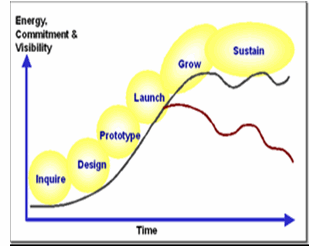Artifact: Annotated Article
Date: December. 2007
Course: Practicum ADHE
Competency: Knowledge of learning approaches and principles
I found this guide (2005) for designing online communities of practice while doing an e-Portfolio search on Educase
The challenge of building online community, as discussed in this guide, is one of the main themes I have been exploring through the practicum and my entire graduate degree. Specifically, the e-Portfolio project as conceived by the TEO at the University of British Columbia requires that the participants engage in social interaction throughout the process, interaction which it is assumed will build towards community.
In this reflection, I will explore the applicability of designing online community during the e-Portfolio process. However, it is important to challenge right the term ‘designing’ community, which suggests a control and determinism that is incongruent with the often organic nature of community.
Nonetheless, the process of building community outlined by the authors is compelling–as seen in the the diagram below.
The lifecycle begins with an analysis of the characteristics and context of the community; then the activities and technologies are designed; the community is piloted through a prototype; the community is launched; members are engaged in collaborative learning activities to engender greater interaction; and finally the community is sustained and the knowledge that is generated in the community is used to guide new directions in the organization or institutions.
To what extent do these steps describe the process that occurs in the development of online communities? I see these guidelines as important but community does not necessarily develop through a pre-defined, linear process. Online community has existed since the birth of the Internet–sometimes springing up suddenly around a common purpose and at other times incrementally developed.
The authors(2005) also suggest that common purpose grows and sustains community and that without this online communities will not be successful. In my own life and teaching practice, I see purpose as the one of the keys to community. In every workplace I have joined there has been a community; when I have completed projects on and offline with people community has developed; and when learners in my classes need to work together to achieve common goals community seems enhanced.
However, I have found community elusive in my e-Portfolio coordination. I believe the central reason for this is not principally the process I followed but the lack of a common purpose. Although all of the teacher candidates have a similar final goal they have no reason to collaborate and work together. Although this development of community is one of the goals of the TEO project there has been little consideration for establishing a common purpose.
References
Cambridge, D. Kaplan, S. Suter, V. (2005) Community of Practice Design Guide, Educase Guide. Retrieved on November 24 from http://www.educause.edu/ir/library/pdf/NLI0531.pdf
